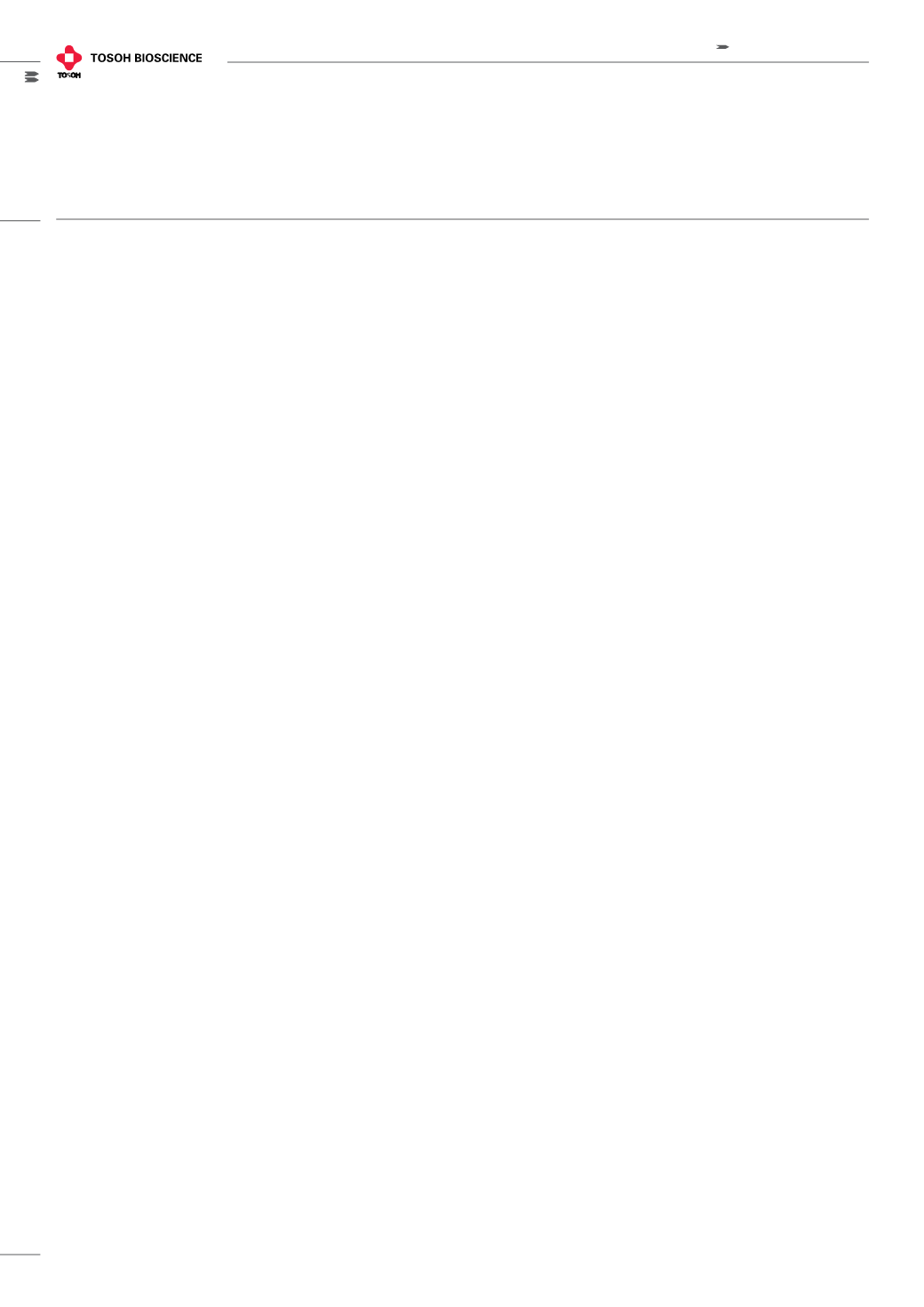
120
APPENDIX
APPENDIX
Basic rules for cleaning TSKgel columns - all types
1.
Clean the column in the reverse flow direction.
2.
During cleaning, do not connect the column to the detector.
3.
Run the column at half the maximum flow rate making
sure to monitor the pressure.
4.
If cleaning with a high or low pH solution, make certain
that the rest of the chromatographic system (pump,
pump seals, injector, etc.) is compatible.
5.
Use at least 5 column volumes (CV) of each cleaning
solution and rinse with 5 CV of ultra pure water between
each cleaning step.
6.
Equilibrate with 5 CV of the mobile phase for the method.
Each type of TSKgel column has a recommended set of cleaning
solutions specific to the column, as described below and on the
OCS sheet. Choose a cleaning solution based upon the column
and sample type. In general low pH salt solution will remove
basic proteins, and organics will remove hydrophobic proteins.
Chaotropic agents will remove strongly adsorbed materials (e.g.
hydrogen bonded). For columns or column types not listed below,
please contact Tosoh Bioscience Technical Service Specialists at
+49 (0) 711 13257-57
.
Cleaning Solutions
Size Exclusion, TSKgel SW and SW
XL
types
1.
Concentrated salt (e.g. 0.5 mol/L Na
2
SO
4
) at low pH (e.g. pH 3.0)
2.
Water soluble organic (MeOH, ACN, EtOH, 10 % - 20 %)
in aqueous buffer
3.
Note:
Detergents
are
difficult
to
remove.
They
require rinsing with 20 to 40 CV of 20% ACN. Therefore
they should be used only when the previous cleaning
solutions are not effective.
Buffered solutions of SDS (0.1 %), urea (8 mol/L), or
guanidin (6 M)
Size Exclusion, TSKgel PW and PW
XL
types
1.
High concentration salt (e.g. 0.5 mol/L - 1.0 mol/L Na
2
SO
4
) in
aqueous buffer
2.
Buffered solutions at low pH (e.g. 2 - 3) or high pH (e.g. 11 - 12)
3.
Water soluble organic (MeOH, ACN, EtOH, 10% - 20%) in
aqueous buffer
4.
Note:
Detergents
are
difficult
to
remove.
They
require rinsing with 20 to 40 CV of 20% ACN. Therefore
they should be used only when the previous cleaning
solutions are not effective.
Buffered solutions of SDS (0.1 %), urea (8 mol/L), or
guanidine (6 mol/L).
Ion Exchange, TSKgel SW-type
1.
High concentration salt (e.g. 0.5 mol/L - 1.0 mol/L Na
2
SO
4
)
in aqueous buffer
2.
Buffered solutions at low pH (e.g. 2 - 3)
3.
Water soluble organic (MeOH, ACN, EtOH, 10% - 20%) in
aqueous buffer
4.
Note: Chaotropic agents are difficult to remove. They
require rinsing with 20 to 40 CV of 20% ACN. Therefore
they should be used only when the previous cleaning
solutions are not effective.
Urea (8 mol/L) or non-ionic surfactant in buffer solution.
Ion Exchange, TSKgel PW-type
1.
Inject up to 1 CV in 250 µL increments of 0.1 mol/L - 0.2 mol/L
NaOH on analytical columns. Inject proportionally larger
volumes on semi-preparative columns.
2.
20 % - 40 % aqueous acetic acid* (Since acid can precipitate
protein it should be used after other cleaning methods.)
3.
Water soluble organic (MeOH, ACN, EtOH, 10% - 20%) in
aqueous buffer
4.
Note: Chaotropic agents are difficult to remove. They
require rinsing with 20 to 40 CV of 20% ACN. Therefore
they should be used only when the previous cleaning
solutions are not effective.
Urea (8 mol/L) or non-ionic surfactant in buffer solution.
Note: Rinse Ion Exchange columns with 5 CV of the appropriate solution
to restore the correct counter-ion before equilibrating with loading
buffer.
Hydrophobic Interaction, TSKgel PW-type
1.
0.1 mol/L - 0.2 mol/L NaOH*
2.
20 % - 40 % aqueous acetic acid* (Since acid can
precipitate protein it should be used after other
cleaning methods.)
Reversed Phase, Silica-based
1.
100% acetonitrile or methanol
2.
Gradient from 10% - 100% acetonitrile in 0.05% trifluoro- acetic
acid
Reversed Phase, Polymer-based
1.
100 % acetonitrile or methanol
2.
0.1 mol/L - 0.2 mol/L NaOH*
3.
20 % - 40 % aqueous acetic acid* (Since acid can precipitate
protein it should be used after other cleaning methods.)
HILIC, TSKgel SW-type
1.
Water
2.
45 % acetonitrile or acetone
3.
0.1 % triethylamine in at least 75 % acetonitrile
4.
50 mmol/L phosphate buffer pH 6.0 in 50 % acetonitrile
Affinity Columns, TSKgel PW-type
Consult theOCS sheet of the specific column type for cleaning directions.
*Inject up to 1 CV in 250 µL increments of solutions 2 & 3 on analytical
columns. Inject proportionally larger volumes on semi-preparative
columns.


